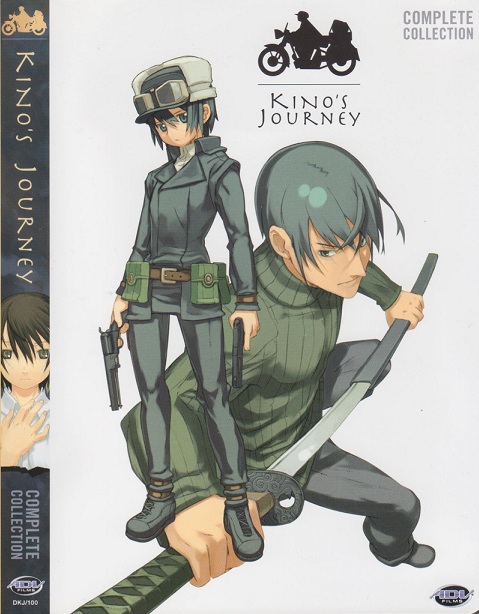Bento Bako fans, you may notice that I’m slacking off a bit recently. Typically I review six manga a week (two per column), but I’ve only been doing one at a time this week. It will probably go this way through the summer. I have several projects I’m working on, including some Manga Moveable Feast essays and a review of the book Dreamland Japan. This has me reading various other things (like re-reading the entire run of Fruits Basket), which gives me less time to read and review new material. Please be patient with me. Today, I’m digging back into my old, personal review blog for a review of a beloved anime which I have been rewatching with a friend. Please enjoy this review of the wonderful anime series Kino’s Journey.
 Title: Kino’s Journey
Title: Kino’s Journey
Volume: Collected series (three discs in one box), $39.98
Director: Ryūtarō Nakamura
Studio: A.C.G.T.
Licensor: ADV Films
Vintage: Originally aired in 2003 in Japan, originally released by ADV in 2004, reviewed version released in 2009
Genre: Adventure, fantasy, science fiction
Kino’s Journey is a really lovely little show. Subtitled “The Beautiful World,” this 13-episode anime lives up to the description. The series is based on a light novel series by Keiichi Sigsawa (he also wrote the light novels that were the basis for the Allison & Lillia anime series, recently licensed and released by Sentai Filmworks). The show follows the young Kino (she’s probably in her early-mid teens, though the time frame is a bit ambiguous) and her talking motorcycle named Hermes as they travel from land to land experiencing the different cultures and people of each place they visit.
The series is very episodic. There isn’t really a single set plot line. Kino and Hermes are simply traveling from place to place. There are a few things that tie the episodes together. Kino learns of things in some lands that she sees the effects of in other places, but otherwise the episodes are stand alone, with recurring themes. As a traveler, Kino spends no more than three days and two nights in any one place, claiming that it is the perfect amount of time to experience a place without staying too long to become attached. She also prefers to observe and tries to make it a point not to involve herself in the affairs of the lands she visits, though she isn’t always successful.
The beauty of the world lies not in conventional beauty, but rather in things that would be considered harsh, brutal, and tragic. The idea being that these things have a beauty as well, or perhaps, that they exemplify what beauty there is. Whether it’s a land where people don’t have to work but work anyway to measure their worth through stress, a land that collects books from all over the world but locks away anything they deem harmful, or two countries that keep their peace through disturbing methods. Though it’s clear that Kino herself doesn’t like violence, she is well armed with a revolver, a pistol, and several knives for her protection. She is an unusually excellent shot for one of her size and age, but she discovers she must find a balance between peace and justified violence. Is it worth killing innocent rabbits to save the lives of a few starving men (meaning, are the men worth the sacrifice)? Does an entire land need to be destroyed for the sake of another? Every episode explores a different aspect of humanity, a different philosophy of life.
Everything about this show falls wonderfully into place – the simple and beautiful animation, a lovely score, good writing, and an excellent English dub by ADV. It is well worth a watch. It’s a little gloomy, but in a very beautiful sort of way. It’s an exploration of life, people, and culture. As is often expressed in the series and the novel, “The world is not beautiful, therefore it is.”
Kino’s Journey is currently available (though likely out of print, unless Section 23/Sentai Filmworks keeps it in print) as a single volume collection, containing all three discs with all thirteen episodes. There aren’t any extras to speak of. Kino is voiced by Ai Maeda and Kelli Cousins, while Hermes is voiced by Ryuji Aigase and Cynthia Martinez. The light novel series the anime is based on, which began in 2000, is currently at fourteen volumes; it was licensed by the now defunct Tokyopop, but only the first volume was published. The series also boasts two video game adaptations, two animated films, and a spin-off manga series (none of which are available in America).
Kris
kristin@comicattack.net
@girlg33k_Kris


Looks like I’m adding another one to the list!
Yesssss, my plan is working!